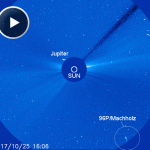China’s Fall Guy: Tiangong-1 Space Lab to Crash in Early 20180
- From Around the Web, Space
- October 28, 2017
China’s Tiangong-1 space lab is headed for an uncontrolled and destructive nose-dive into Earth’s atmosphere early next year.

China’s Tiangong-1 space lab is headed for an uncontrolled and destructive nose-dive into Earth’s atmosphere early next year.

When it comes to temperature—we know that there’s an absolute zero. But is there an absolute ‘hot’?

Conspiracy theorists believe a UFO the size of Jupiter has crashed into the sun. Bizarre images captured by the Solar and Heliospheric Observatory (SOHO) spacecraft, which is jointly run by Nasa and the European Space Agency, appear to show and object hovering close to the surface. Russian website Pravadu.ru describes the UFO as being made up of a transparent

The new technique offers a less permanent way to edit the genome.

If you have long suspected the mainstream is being less than honest [or simply delusional] when they describe Comets as “dirty snowballs” or [more recently] “icy dirtballs” then you might be interested to discover Close Cometary Encounters are associated with sudden spikes in the level of Thorium 232.

It is often assumed that a structure’s surface can be appropriately represented as a two-dimensional area, completely flat and devoid of any depth.

People are fascinated with rankings, and UFOs are no different. People want to know where the top UFO hot spots are. So here it is: the top 25 cities in the U.S. for UFO sightings!

Deep inside the orbit of Mercury, unusual comet 96P/Machholz is diving toward the sun today.

Organized into a chronology that starts with “in the beginning” and ends with the advent of civilization, it brings together myths from many cultures (including the Sumerians, the Greek, the Maya and the Aborigines of Australia) and explores them in the context of current scientific discoveries. The result is a mind-blowing re-visioning of human origins through close reading of ancient texts.

New research shows that people with blue eyes have a single, common ancestor. Scientists have tracked down a genetic mutation which took place 6,000-10,000 years ago and is the cause of the eye color of all blue-eyed humans alive on the planet today.